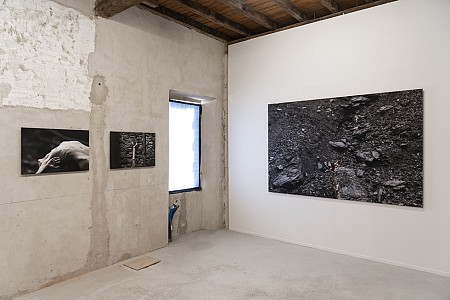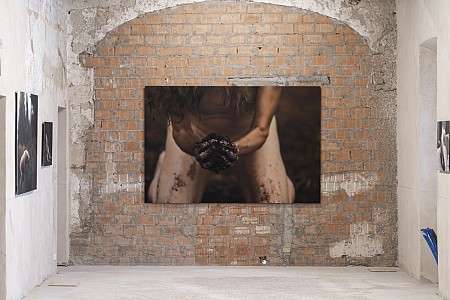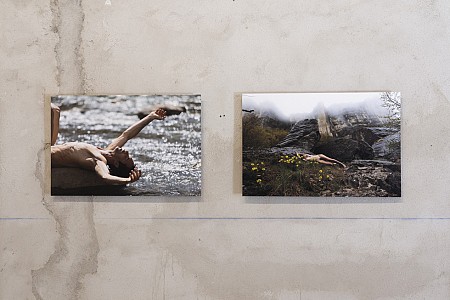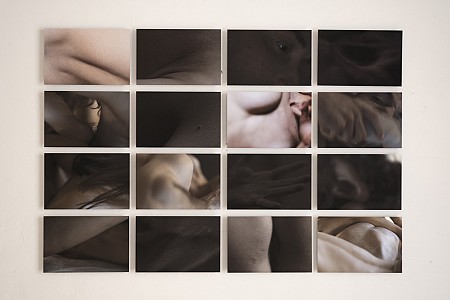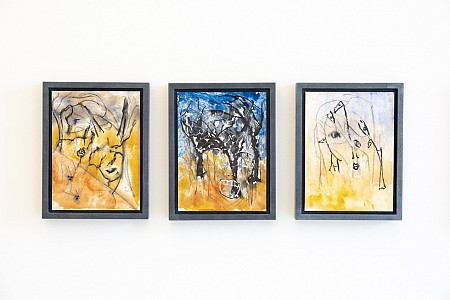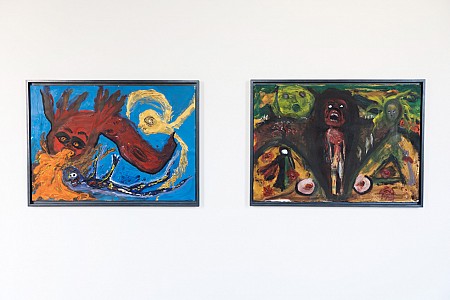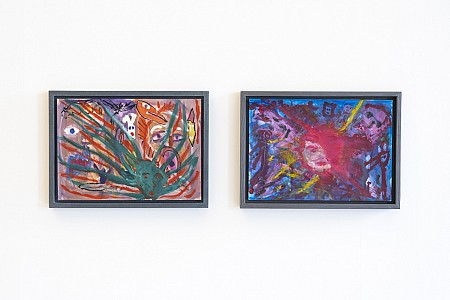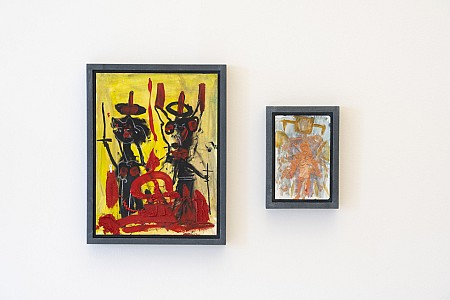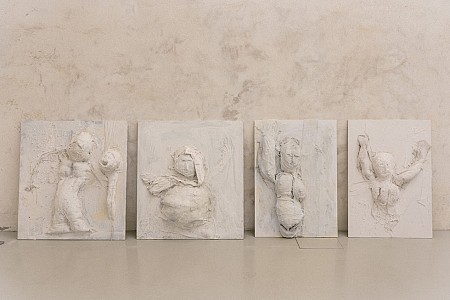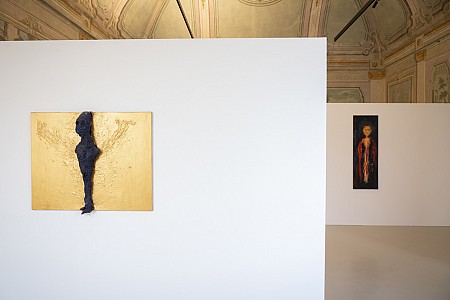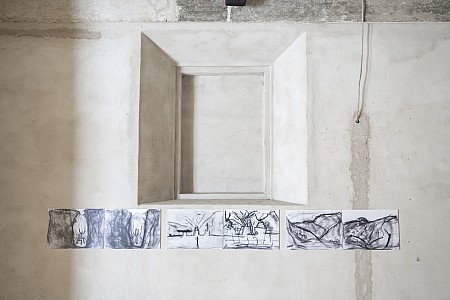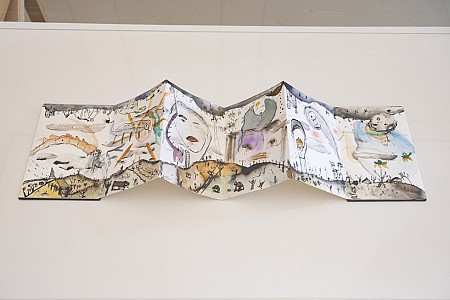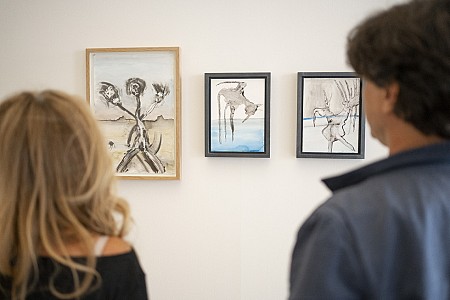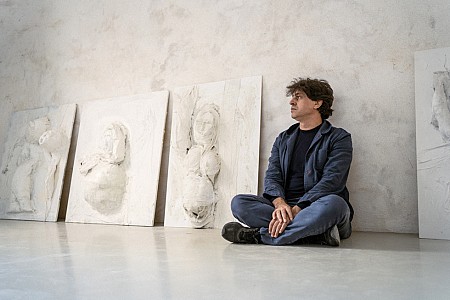Sound art, Sculpture, Score, Video art, Photographs.
Exhibition curated by Marina Dacci.
Il Bestiario della Terra, Chiostri di San Pietro, Reggio Emilia, Reggio Parma Festival 2022, October 1 to November 13
,-Chiostri-di-San-Pietro-Reggio-Emilia,-2022-Ph.-Andrea-Mazzoni.jpg)
"Membrane" stands at the conclusion of the first part of the meta-opera Il Bestiario della Terra, specially created by artist Yuval Avital as Project of the year for the Reggio Parma Festival 2022. Membrane is like the cry of the last man on Earth – now an adult and aware of the split from the State of Nature, he continues to attempt a reconnection with that which spawned him, but he knows that it is fatigue that is the backdrop to this relationship. It is a movement, lasting the course of his entire life, that has made him first assume the role of executioner, seeking to dominate and overpower the Great Mother, and then that of victim, when, nolonger recognized by her, he is rejected by her. Taking charge of this condition, which is nothing but the human condition, is not, however, a reason for abandoning the encounter/clash, but a trace of its shifts and the vibrations that this complex relationship produces. Membrane is spread over two floors. A first part is designed to accompany the visitor intothe pictorial and sonic spheres of the narrative, where each painting is an expression of this oscillation and each sound sculpture its totem. At the metaphorical and spatial centre of the drawings is the Man, who in the figurative depiction takes an upward direction. In the obsessive repetition of figures, whether belonging to series or the result of isolated events, it is possible to find the existential message: is anyone listening to this cry? Is Earth still capable of understanding its son, of welcoming and guiding him, or does a chasm separates them? Not offered is a solution but a trace of the continuous shifts in the relationship.
The figures in the exhibition are as diverse as the experiences of the men are diverse: Yuval Avital does not wantto leave any human type unexpressed and unrepresented. The crowd, in all its heterogeneity, deserves to bear witness to the human condition. However, the pictorial language, although figurative, does not rest on gritty realism; the strokes seem to have been guided by a force inthe middle between sleep and wakefulness, evoking ancestral ways of being. Membrane presents the large opus Foreign Bodies on the upper floor, in close dialogue with the pictorial apparatus of the rooms below. In Foreign Bodies the human figure emerges statuesquely from the powerful and wild natural background (rivers, ice deserts etc.) or aviolated one (by road signs, large water pipes, dams). The performers, visible through aniconic-sound polyptych* composed of 14 parallel projections (in a loop of more than 80min) and photographs, do not dance or act fluidly but take up emblematic positions, as if o transpose the essence of the monumentality of the gesture onto the screen. Thanks to Reggio Parma Festival, Foreign Bodies is enriched with a third chapter – in this occasion made entirely in Italy, in the Emilia-Romagna region – that picks up and expands on theprevious ones, which are also in the exhibition. For the first time, a male figure is introduced (dancer Gabriele Corrado, soloist of Teatro La Scala), intended to archetypically symbolize the labour necessary for domestication, the effort required for reconciliation, and the endeavourof a tension whose outcome is not guaranteed. Mother no longer recognizes her son, whoover time has become so detached that he has become something else, like a foreign body, forcibly introduced into the organism nature, thus reversing the medical term intended tosymbolize an invasion to the detriment of the human body. Moreover, the addition of themale presence in a scenario that in the previous chapters had been dominated entirely by thefemale figure, hints at an Edenic ideal reinterpreted in a contemporary key: an Adam and Eve(in this case Israeli choreographer Maayan Cohen Marciano) who are no longer served by the products of the earth in a necessary and predetermined harmony but who know that they are the fruit of continuous bargaining. Compared to the first and second chapters we have to note the introduction of a collective dimension; thus, in some scenes, a group of dancers (from the MM Contemporary company) makes an appearance. This change is not to bemisunderstood, however; the dimension of uniqueness of each performer is safe guarded asin a heterophonic chorus. The different bodies, set in resonance, vibrate together shaping an existential equation.
The Membrane project articulates and inhabits several rooms in the Chiostri di San Pietro. Painting, drawing, photography, video and sound dialogue in unison: they are an invitation to break the rigid boundaries between man andnature considering both an essential part of a universal energy in which toinscribe. The environment is not only that which is external to us but is alsothe Umwelt: our perceptual and operational mental environment. So, thewhole project is a search for identity.The sound score, the driving element, triggers and connects the static and moving images. Sound leads to the deep roots of collective memory and then brings back conscious light. Tension and abandonment are salient features of the movement of the bodies in the performances on par with Yuval Avital’s instinctive pictorial gesture that characterizes his artistic production: both open and dissolve in a close relationship with the earth with an archaic and symbolic flavour and a strong thaumaturgical impact.
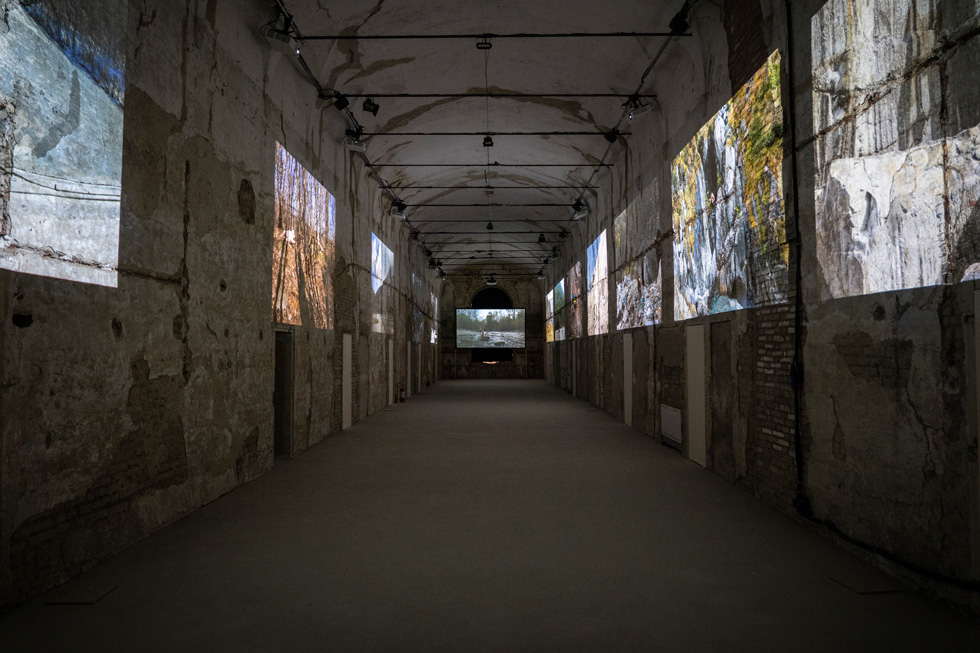
Foreign bodies developed into different chapters and areas over six years.A constant element accompanying its realization is an ethical sense of new forms of communion in which the performers’ explorations, techniques, and bodies are inextricably linked to the place that is, at once, intimate and concrete. This path of regeneration is offered here with a selection of photographic shots and iconic-sound installations of the three areas where it took place: Switzerland, Germany, and Emilia-Romagna. Constantly listening to the earth, the performers’ bodies are sounding boards between the earth and their intimate dimension in which pleasure, fear, pain and sadness mingle. The work in progress of the project is complex and multifaceted. After the artist’s choice of areas and performers, the artistic execution with a strong ritual flavour begins: listening to the place, intimate exchange between artist and dancers, and execution of the archetypal postures devised by Yuval Avital that facilitate a reconnection of the body with the earth and in which the body itself becomes landscape. Throughout the process, the artist’s exchange and supervision with the performers is constant. Finally, the writing of a sound score by Avital that starts with the recording of digitally processed ambient sound to which a sound layer obtained by adigital generative algorithm is added. The result of this grafting is a sonorityonly partially controlled by the artist. Each scene in the project has its own sound connected to individual performers.
.jpg)
The exhibition of paintings and drawings is a kind of viaticum, a solitary journey of self-analysis and awareness made by the artist. It is divided into a pathway in which Avital – from room to room – invites the viewer to enter. The sequence of works inthe seven rooms unravels with continuity in four moments: On the way / To sink; Contact and new lymph; Emerge and rise; Return to the world with new memories. The painting consists of an intense and mellow, often sombre colour palette, and is expressed in quick, extemporaneous marks as it occurs in capturing apparitions and illuminations. It is a breakthrough into the heart of the earth to find one’s own nature in which fire is a central element in the sinking and from which archetypaland ancestral marks and figures take shape. In the drawing, the colour liquefies and dissolves evoking the resurfacing, rising, blowing, and liberation of magical and evenmystical flavour and in which water and air are protagonists. Sound, ever-present in the artist’s research, also accompanies the visual journey here and is made by subjects symbolically linked to his quest: the camel, great traveller; the mammoth, bearer ofancestral memories; and the heart, which is the key to tackling the journey.

